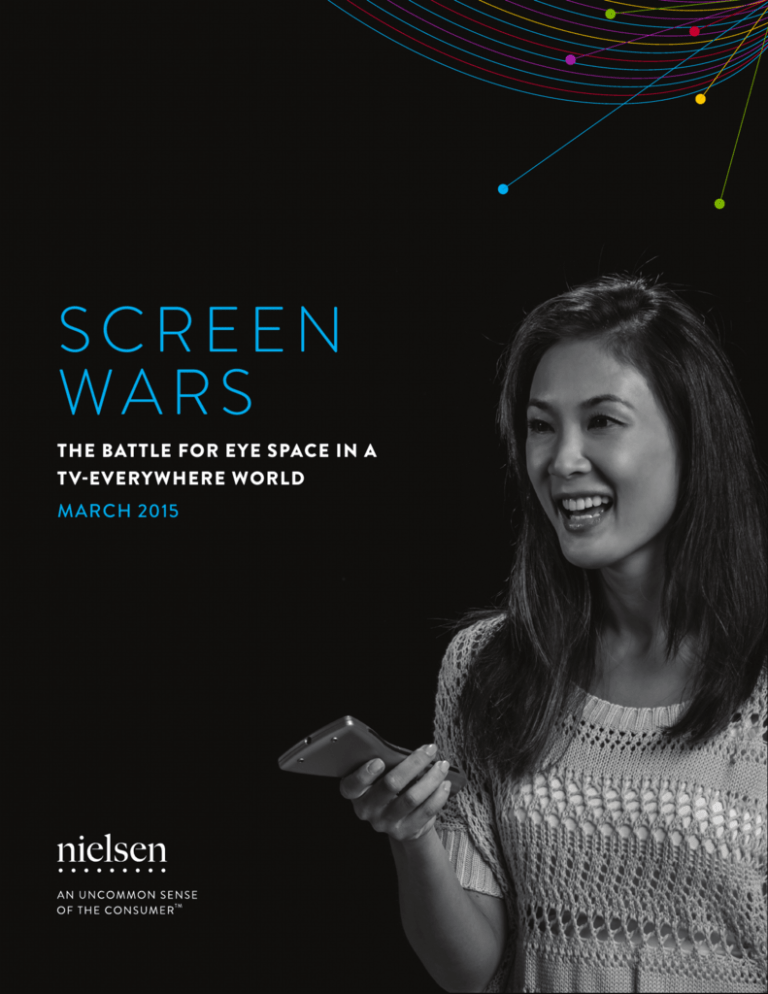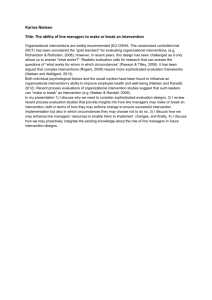
SCREEN
WA R S
THE BATTLE FOR EYE SPACE IN A
T V-EVERYWHERE WORLD
MARCH 2015
Copyright © 2015 The Nielsen Company
1
DESPERATELY
SEEKING THE
AUDIENCE
AROUND THE WORLD
76% enjoy the freedom of being connected
anywhere, anytime
69% think face-to-face interactions are being
replaced with electronic ones
63% believe bigger is better when it comes to
screen size
65% prefer to watch video programming live,
at its regularly scheduled time
49% say they watch live video programming
content more if it has a social media tie in
Mobile phones are the most commonly cited
go-to device for on-the-go viewing
Growing white-space digital opportunities
include industries such as health care,
education, grocery retailing and finance
2
SCREEN WARS
We are living in a world of 24/7 connectivity. We access content on our
own terms, and we like it that way. Across the globe, more than threequarters (76%) of respondents in a Nielsen online survey of digital
attitudes and behaviors say they enjoy the freedom of being connected
anywhere, anytime. While this flexibility can be a benefit to us, it
represents a huge challenge for brands and content providers vying for
our attention.
ABOUT THE GLOBAL
SURVEY METHODOLOGY
The findings in this survey are
based on respondents with online
access in 60 countries. While
Technology is dramatically transforming the way in which we interact
with the world, including how we live, work and communicate. From
keeping tabs on friends via social media, to skipping lines at the store
by shopping online, technology continues to reshape our everyday
habits. In fact, nearly seven-in-10 (69%) global respondents think
face-to-face interactions are being replaced with electronic ones. And
the digital landscape is only getting more crowded, as a new wave of
digital devices, such as wearable and connected car technologies, gain
traction.
an online survey methodology
The media industry, too, is experiencing a revolution, thanks to the
proliferation of digital devices and access points, including TVs,
connected TV’s, smartphones, PC’s, tablets and gaming consoles. The
traditional boundaries between devices and formats have blurred, and
content once confined to a single device can now be delivered across
multiple platforms. And it’s not just devices and platforms competing
for our time and attention—fragmentation is occurring within
mediums, too.
be younger and more affluent
allows for tremendous scale
and global reach, it provides a
perspective only on the habits
of existing Internet users, not
total populations. In developing
markets where online penetration
is still growing, audiences may
than the general population of
that country. In addition, survey
responses are based on claimed
behavior rather than actual
metered data.
“It has never been more important to understand consumer behavior
than in today’s rapidly evolving digital environment,” said Megan
Clarken, executive vice president, Nielsen Global Watch Product
Leadership. “Choice creates not only complexity, but also opportunity.
The media industry must embrace the changing landscape and adapt
their strategies to fit with this new reality, offering engaging and
relevant content that is easily accessible across devices and channels.”
While media fragmentation is happening across all formats, the
findings in this report focus specifically on video programming, which
we define as any type of content, such as TV, cable shows, professional
video or user-generated content that is watched on your TV, PC,
mobile phone, tablet or e-reader device. The Nielsen Global Digital
Landscape Survey polled 30,000 online respondents in 60 countries to
understand how the changing digital landscape is affecting how, where
and why we watch video programming. We also examine consumption
preferences for video programming, including the devices most
commonly used for selected genres and the devices used to view video
at home and on the go.
Copyright © 2015 The Nielsen Company
WE ACCESS
CONTENT ON OUR
OWN TERMS, AND
WE LIKE IT.
3
A NEW VIEW
While the explosion of devices and platforms has given us more
access to content and brands than ever before, video programming
remains a strong influence in our lives. In fact, more than half of global
respondents (55%) say video programs are an important part of their
lives. The way audiences watch video, however, is shifting.
As it turns out, size does matter—when it comes to the way we like to
watch video programming. The majority of global respondents (63%)
think bigger is better when it comes to screen size, but they also
appreciate the convenience and portability of mobile devices. Nearly
six-in-10 global respondents (59%) think watching video programming
on their mobile device is convenient. In addition, more than half (53%)
say a tablet is just as good as a PC or laptop computer for watching
programming.
Respondents also like the ability to control how and when they interact
with content and brands. Sixty-four percent of global respondents say
they catch up with their favorite programming by watching several
episodes on the same day. The same percentage (64%) say watching
time-shifted programming better accommodates their schedule. In
addition, many consumers are using technology to limit the amount of
advertising clutter in their lives. Two-thirds of global respondents say
they switch to another channel when a commercial comes on.
“WATCHING TV IN A LINEAR FASHION IS
CHANGING FOR MANY, AS WE ARE NOW IN MORE
CONTROL OF WHAT WE WATCH, WHEN WE WATCH
AND WHERE WE WATCH,” SAID CL ARKEN. “MOST
IMPORTANT IS UNDERSTANDING HOW VIEWING
PATTERNS ARE SHIFTING AND DETERMINING
THE DRIVING FORCES BEHIND THE CHANGE.
WHILE TECHNOLOGY CONTINUES TO EVOLVE,
SO TOO ARE OUR HABITS AS A DIRECT RESULT.
MULTI-TASKING HAS TAKEN ON A WHOLE NEW
MEANING AS OUR DIGITAL DEVICES ENABLE US
TO CONNECT IN WAYS—AND IN PL ACES—WE MAY
NEVER HAVE THOUGHT POSSIBLE.”
4
SCREEN WARS
VIEWERS HAVE GREATER POWER OVER HOW,
WHEN AND WHERE THEY WATCH
GLOBAL AVERAGE PERCENTAGE WHO STRONGLY OR SOMEWHAT AGREE
67%
65%
64%
64%
63%
59%
Switch to another channel
when a commercial
advertisement comes on
Often catch up with their
favorite programming by
watching several episodes
on the same day
Think the biggest screen is
the best screen for watching
video programming
Prefer watching video
programming live
Say watching timeshifted programming
better accommodates
their schedule
Say watching video
programming on
their mobile device is
convenient
53%
Think a tablet is just as good
as a PC or laptop computer
Source: Nielsen Global Digital Landscape Survey, Q3 2014
Copyright © 2015 The Nielsen Company
5
THE PUSH HAS
NOW BECOME THE
PULL
Despite our domination over the dial, scheduled viewing hasn’t gone
away for most of us. In fact, 65% of global respondents still prefer
to watch video programming live, at its regularly scheduled time.
The continued preference for live programming is further supported
in part by social media, which serves as the digital age’s proverbial
water cooler. The power is shifting from the provider to the people.
More and more frequently, real-time conversations on social media
are replacing physical gatherings around the water cooler to talk
about a previous night’s episode of our favorite TV show. Not only
does watching in real-time avoid spoilers, but live TV has become a
social event that goes way beyond the confines of our living rooms.
More than half of global respondents (53%) say they like to keep
up with shows so they can join the conversation on social media,
and nearly half (49%) say they watch live video programming
more if it has a social media tie in. Forty-seven percent of global
respondents say they engage with social media while watching video
programming.
Asia-Pacific and Africa/Middle East respondents are particularly
engaged in social media while viewing, exceeding the global average
for attitudes related to social media use. For example, 65% of AsiaPacific and 57% of African/Middle Eastern respondents watch live
programming if it has a social media tie in (compared with 49%
globally). In addition, more than six-in-10 respondents in Asia-Pacific
(64%) and Africa/Middle East (62%) say they like to keep up with
shows so they can join the conversation on social media.
Using social media while watching video programming is only
one example of second-screen usage. Getting ancillary content,
researching information about characters, playing mobile games
or reading/watching behind-the-scenes interviews are becoming
common practices. More than half of global respondents (58%) say
they browse the Internet while watching video programming.
6
“THE SECOND, THIRD
AND SOMETIMES FOURTH
SCREEN IS BECOMING
A FUNDAMENTAL
EXTENSION OF THE
VIEWING EXPERIENCE,”
SAID CL ARKEN. “WHILE
MULTIPLE SCREENS
GIVE VIEWERS MORE
OPTIONS, THEY ALSO GIVE
CONTENT PROVIDERS
AND ADVERTISERS
MORE OPPORTUNITIES
AND WAYS TO REACH
AND ENGAGE WITH
VIEWERS. WELL-DESIGNED
EXPERIENCES CAN NOT
ONLY MAKE THE VIEWING
EXPERIENCE MORE
ENJOYABLE, BUT THEY
MAXIMIZE THE TIME USERS
SPEND INTERACTING WITH
BRANDS, TOO.”
SCREEN WARS
SECOND AND THIRD SCREENS ARE BECOMING AN EXTENSION
OF THE VIEWING EXPERIENCE
PERCENTAGE WHO STRONGLY OR SOMEWHAT AGREE
GLOBAL AVERAGE
ASIA-PACIFIC
AFRICA/MIDDLE EAST
LATIN AMERICA
EUROPE
NORTH AMERICA
SECOND SCREEN
I BROWSE THE INTERNET WHILE WATCHING VIDEO PROGRAMMING
58%
63%
44%
61%
60%
62%
SOCIAL MEDIA
I LIKE TO KEEP UP WITH SHOWS SO I CAN JOIN THE CONVERSATION ON SOCIAL MEDIA
53%
64%
62%
36%
51%
39%
I WATCH LIVE VIDEO PROGRAMMING CONTENT MORE IF IT HAS A SOCIAL MEDIA TIE IN
49%
65%
57%
26%
41%
33%
Source: Nielsen Global Digital Landscape Survey, Q3 2014
Copyright © 2015 The Nielsen Company
7
STRATEGIES FOR
SECOND-SCREEN
SUCCESS:
8
•
Be Social: Nielsen research shows that social media can increase
program awareness, make the experience more enjoyable for
audiences and keep viewers engaged. The desire to be part of the
collective conversation can be a powerful motivator to tune in
live. Second-screen strategies should include an interactive/social
component that allows users to interact and turn the program into a
“can’t miss” event or experience.
•
Be (Inter)active: Keep content fresh to maximize time spent with
the content and drive repeat visitation. Also, include interactive
experiences to make users feel involved and deepen their connection
with the program.
•
Be Available: Designers cannot focus on a single screen. Rather, they
must ensure content is accessible wherever users are and that the
user experience is enjoyable across all devices.
SCREEN WARS
DEVICES
PROLIFERATE
BUT TV STILL
DOMINATES
Whether it’s watching a sporting event, news show, documentary or
movie, TV remains at the center of video consumption. It is the most
frequently cited device for watching nearly all types of programming
genres included in the survey—by a wide margin. The exception: shortform video (typically less than 10 minutes long), which is cited as
more commonly viewed on computers, mobile phones and tablets. A
computer is the second-most commonly mentioned viewing device for
nearly all genres, and it tops the list of devices used to watch shortform content. A smaller, but notable, proportion of consumers watch
video content on a mobile phone or tablet, while viewing on e-readers
and/or gaming consoles has not yet gained traction.
TV is the primary device of choice for viewing video across all
generations, but its leadership status is highest among older
consumers. The percentage of respondents who say they watch on a
television is highest among the Silent Generation (ages 65+), Baby
Boomers (ages 50-64) and Generation X (ages 35-49) and lowest
among Generation Z (ages 15-20) and Millennials (ages 21-34).
On average, 91% of Silent Generation respondents say they watch
video programming on TV, followed by 84% of Baby Boomer, 75% of
Generation X and 62% of Millennial and Generation Z respondents.
Computer and mobile phone use, on the other hand, is highest among
the youngest consumers. More than four-in-10 Generation Z and
Millennial respondents (42% each) say they watch video programming
on a computer, compared with 31% of Generation X, 25% of Baby
Boomer and 15% of Silent Generation respondents. Similarly, onefifth of Millennial and Generation Z respondents (22% and 20%,
respectively) say they watch on a mobile phone, compared with 14%
of Generation X, 6% of Baby Boomer and 2% of Silent Generation
respondents. Tablet use is highest among Millennial and Generation
X respondents, cited by 16% and 15% of respondents, respectively. In
comparison, 12% of Generation Z, 8% of Baby Boomer and 4% of Silent
Generation respondents say they watch video on a tablet.
Copyright © 2015 The Nielsen Company
THE INFOGRAPHIC
ON THE NEXT PAGE
PROVIDES AN IN-DEPTH
VIEW OF THE DEVICES
CONSUMERS ARE
USING TO WATCH VIDEO
PROGRAMMING.
9
TV IS THE PRIMARY DEVICE CHOICE FOR WATCHING VIDEO
SELF-REPORTED DEVICE PREFERENCES FOR WATCHING VIDEO BY GENRE*
TELEVISION
COMPUTER
MOBILE PHONE
TABLET
NEWS SHOWS
DRAMAS
VARIET Y SHOWS
COMEDIES
SPORTING EVENTS
DOCUMENTARIES
COOKING SHOWS
REALIT Y SHOWS
AWARDS SHOWS
MOVIES
CHILDERN’S SHOWS
SPORTS NEWS
SOAP OPERAS
GAME SHOWS
HOW-TO SHOWS
SHORT-FORM VIDEOS
Source: Nielsen Global Digital Landscape Survey, Q3 2014
* Among respondents who say they watch this type of programming
10
SCREEN WARS
“BEST IN SCREEN”
NOW SHOWING
ON A DEVICE
NEAR YOU
While TV remains the primary device for video consumption in the
home, mobile phones are the most commonly cited go-to device for
on-the-go viewing. But the full story is actually more complicated.
Device viewing is largely situational; it depends on where we are,
whom we’re with and what we’re doing. Even at home, the traditional
TV may not automatically be the go-to device. For example,
among respondents who watch video programming when they’re
home alone, the largest percentage (63%) say they watch video
programming on the TV, but computer is a relatively close second,
cited by 56% of global respondents. In addition, 34% percent say
they use a mobile phone and 22% cite a tablet to watch video
programming.
“The lines between devices continue to blur and the best available
screen for viewing may vary widely as viewers move through
the day,” said Clarken. “Audiences will choose the device that is
most compatible with their needs at the time they want to watch.
Therefore, content must seamlessly flow across time, location and
device.”
Copyright © 2015 The Nielsen Company
11
PREFERRED SCREEN DEPENDS ON ACTIVIT Y AND LOCATION
SELF-REPORTED DEVICE PREFERENCES FOR WATCHING VIDEO BY ACTIVIT Y*
TELEVISION
COMPUTER
MOBILE PHONE
TABLET
SPENDING TIME
WITH FAMILY
WHILE
EATING
SITTING ALONE IN
MY HOME
PASSING THE
TIME
WHILE COOKING
WHILE EXERCISING
SPENDING TIME
WITH FRIENDS
WAITING FOR A
FRIEND
SITTING IN A
DOCTOR’S OFFICE
WHILE
DRIVING
WHILE IN THE
BATHROOM
WHILE
AT SCHOOL
WHILE
AT WORK
WHILE
SHOPPING
COMMUTING
FROM WORK
Source: Nielsen Global Digital Landscape Survey, Q3 2014
*Excludes respondents who do not take part in or do not watch programming while doing this activity
12
SCREEN WARS
MOBILE VIEWING
PREFERENCES
VARY BY REGION
There are a few regional differences in how viewers watch video
programming. In-home preference of mobile phones for video viewing
is higher in Asia-Pacific, Africa/Middle East and Latin America than in
Europe and North America. For example, among viewers who say they
watch video programming when they’re home alone, 41% in Africa/
Middle East, 40% in Asia-Pacific and 38% in Latin America say they
do so on a mobile phone, compared with 24% in Europe and 22% in
North America.
Outside the home, mobile phone use is similar in Asia-Pacific, Africa/
Middle East and Europe. It’s above the global average in Latin America
and below in North America. For example, among respondents who
watch video programming on their commute to and from work, 59%
of respondents in Africa/Middle East, 62% in Europe and 66% in
Asia-Pacific watch on their mobile phone, compared with 80% in Latin
America and 48% in North America.
Generation Z and Millennial respondents are more likely than their
older counterparts to report using one or more devices to watch
video in all of the locations included in the survey. In-home use of
mobile phones and computers is particularly high among the youngest
consumers. Forty-two percent of Millennial and 38% of Generation Z
respondents who watch video while sitting at home say they do so on
their mobile phone, compared with 30% of Generation X, 18% of Baby
Boomer and 6% of Silent Generation respondents.
Outside the home, a mobile phone is the device of choice for nearly
all generations. Sixty-six percent of Generation X and Baby Boomer
respondents who watch video on their commute home from work do
so on a mobile device, while 65% of Millennial, 64% of Generation Z
and 56% of Silent Generation respondents do so, too. Similarly, among
respondents who watch video while shopping, 74% of Baby Boomer,
70% of Silent Generation, 66% of Generation X and Millennial and
65% of Generation Z respondents say they watch on a mobile phone.
Copyright © 2015 The Nielsen Company
“GENERATION Z AND
MILLENNIALS, THE
DIGITAL NATIVES, ARE
VORACIOUS CONSUMERS
OF MEDIA AND MOBILE
PHONES ARE AT THE
CENTER OF THEIR LIVES,”
SAID CL ARKEN. “FOR
YOUNGER CONSUMERS,
THE MOBILE PHONE IS
NO LONGER JUST FOR
USE ON THE GO, BUT
EVERYWHERE—EVEN
THEIR LIVING ROOMS.
CONTENT PROVIDERS
AND ADVERTISERS NEED
TO BE FLEXIBLE WITH
THEIR APPROACHES
IN ORDER TO REACH
CONSUMERS WHERE
THEY ARE, ON THE
DEVICE THEY ARE
USING AND DURING THE
ACTIVITIES IN WHICH
THEY PARTICIPATE.”
13
YOUNGEST CONSUMERS ARE HEAVIEST MOBILE USERS,
REGARDLESS OF LOCATION
AVERAGE PERCENTAGE WHO SAY THEY USE DEVICE TO WATCH
VIDEO PROGRMMING IN SELECTED LOCATION*
TELEVISION
COMPUTER
MOBILE PHONE
TABLET
IN-HOME
GENERATION Z
(15-20)
MILLENNIALS
(21-34)
GENERATION X
(35-49)
BABY BOOMERS
(50-64)
SILENT
GENERATION
(65+)
53%
65%
38%
55% 60%
69%
OUT-OF-HOME
52%
42%
20%
24%
30% 24%
13%
16%
17%
59%
26%
59%
24%
57%
23%
79%
52%
18% 16%
20%
15%
39%
58%
24%
13%
17%
18%
14%
90%
34% 6%
22%
42%
11%
Source: Nielsen Global Digital Landscape Survey, Q3 2014
* Among those who watch video programming in a selected location
14
SCREEN WARS
THE NEXT WAVE
OF DIGITAL
WHITE-SPACE
OPPORTUNITIES
Today, people across the globe use electronic devices for three primary
purposes: relationship building/maintaining, information gathering and
entertainment viewing. More than six-in-10 global respondents say they
use electronic devices to connect with family and friends (65%), get
news (63%), listen to music (63%) and/or take pictures/videos (61%).
But how do we plan to use electronic devices in the future, and where
are the best opportunities for future growth?
Rating the willingness to use an electronic device for 14 activities, a few
common themes emerge across the globe.
HEALTH CARE: Sharing medical information is among the top activities
for which respondents are willing to use an electronic device in all
five regions. This is particularly attractive in developing regions where
access to medical services may not be as readily available. Sixty percent
of respondents in Asia-Pacific, 52% in Africa/Middle East, 50% in Latin
America say they’re willing to use an electronic device to share medical
information; 45% in North America and 39% in Europe are willing.
EDUCATION: More than half of global respondents (52%) say they’re
willing to use an electronic device to get an education. Willingness is
highest in Asia-Pacific and North America (57% in each region); it’s
lowest in Latin America (36%), but this region also has the highest
percentage of respondents who say they’re already using an electronic
tool to get an education.
Copyright © 2015 The Nielsen Company
15
GROCERY RETAILING: While less than one-third of global respondents
(32%) say they currently use an electronic device to buy groceries, nearly
half (48%) are willing to do so. Willingness is highest in the regions
with the highest percentage of respondents already buying groceries
electronically (Asia-Pacific and Africa/Middle East). North America,
which has the lowest percentage of respondents who say they’re
currently buying groceries with an electronic device, follows closely
behind. Half of respondents in each region (54% in Africa/Middle East,
51% in Asia-Pacific and 50% in North America) are willing to use an
electronic device to buy groceries, while four-in-10 respondents in Latin
America (46%) and Europe (40%) are willing to do so.
FINANCE: Fewer developing-market respondents say they’re currently
using electronic devices to pay bills and conduct banking business, but
there is interest to do so in the future. More than four-in-10 respondents
in Asia-Pacific (47%), Africa/Middle East (44%) and Latin America
(41%) say they are willing to pay their bills with an electronic device.
Similar percentages (46% in Asia-Pacific, 45% in Africa/Middle East and
36% in Latin America) are willing to conduct banking business with an
electronic device.
16
SCREEN WARS
TOP DIGITAL OPPORTUNITIES BY REGION
PERCENTAGE WHO ARE DEFINITELY/SOMEWHAT WILLING TO USE AN ELECTRONIC
DEVICE FOR SELECTED ACTIVITIES
GLOBAL AVERAGE
SHARE MEDICAL INFORMATION
52%
GET AN EDUCATION 52%
BUY GROCERIES 48%
FIND A JOB 46%
CONDUCT RESEARCH 44%
PAY BILLS 40%
FIND A DATE 40%
CONDUCT BANKING BUSINESS
38%
WATCH VIDEO PROGRAMMING CONTENT 36%
TAKE PICTURES/VIDEOS 32%
SHARE PICTURES/VIDEOS 32%
EUROPE
ASIA-PACIFIC
GET AN EDUCATION BUY GROCERIES SHARE MEDICAL INFORMATION 45%
40%
39%
SHARE MEDICAL INFORMATION GET AN EDUCATION CONDUCT RESEARCH LATIN AMERICA
60%
57%
56%
NORTH AMERICA
SHARE MEDICAL INFORMATION BUY GROCERIES PAY BILLS 50%
46%
41%
GET AN EDUCATION BUY GROCERIES FIND A JOB 57%
50%
46%
AFRICA/MIDDLE EAST
BUY GROCERIES
SHARE MEDICAL INFORMATION CONDUCT BANKING BUSINESS 54%
52%
45%
Source: Nielsen Global Digital Landscape Survey, Q3 2014
Copyright © 2015 The Nielsen Company
17
LOOKING
FOR DIGITAL
EXPANSION
OPPORTUNITIES?
LOOK TO THE
YOUNG, BUT DON’T
FORGET THE OLD
Millennial, Generation Z and Generation X respondents have the highest
self-reported digital participation rates for the majority of the activities
included in the survey, and they are also the most willing to participate
in those they’re not already doing.
A few activities, however, have cross-generational appeal. More than
half of consumers in all generations say they use digital devices to get
news and connect with friends and family. In addition, more than half of
Generation Z, Millennial, Generation X and Baby Boomer respondents
say they use electronic devices to listen to music and take or share
photos. Not surprisingly, digital participation among Silent Generation
respondents in these activities is significantly lower. However, there are
a few activities where older generations participate at higher rates than
their younger counterparts and they include: banking, paying bills and
conducting research.
“THE PERVASIVE REACH OF DIGITAL’S INFLUENCE
IS FAR AND WIDE, REACHING ALL DEMOGRAPHIC
SEGMENTS,” SAID CL ARKEN. “WHILE DIGITAL
USAGE LEVELS FOR CERTAIN ACTIVITIES MAY BE
UNEVEN TODAY ACROSS AGE GROUPS, THAT IS
CHANGING EVERY DAY AND WILL CONTINUE TO
DO SO IN THE YEARS TO COME.”
18
SCREEN WARS
COUNTRIES IN THE STUDY
EUROPE
ASIA-PACIFIC
MARKET
INTERNET PENETRATION
MARKET
INTERNET PENETRATION
Austria
Belgium
Bulgaria
Croatia
Czech Republic
Denmark
Estonia
Finland
France
Germany
Greece
Hungary
Ireland
Israel
Italy
Latvia
Lithuania
Netherlands
Norway
Poland
Portugal
Romania
Russia
Serbia
Slovakia
Slovenia
Spain
Sweden
Switzerland
Turkey
United Kingdom
Ukraine
87%
90%
59%
71%
78%
97%
83%
97%
83%
87%
60%
75%
79%
76%
59%
75%
69%
96%
95%
67%
65%
51%
61%
65%
82%
76%
75%
95%
89%
57%
90%
42%
Australia
China
Hong Kong
India
Indonesia
Japan
94%
47%
81%
20%
28%
86%
Malaysia
New Zealand
Philippines
Singapore
South Korea
Taiwan
Thailand
Vietnam
67%
95%
41%
80%
92%
80%
30%
44%
LATIN AMERICA
MARKET
INTERNET PENETRATION
Argentina
Brazil
Chile
Colombia
Mexico
Peru
Venezuela
75%
54%
67%
62%
49%
42%
50%
MIDDLE EAST / AFRICA
MARKET
INTERNET PENETRATION
Egypt
Pakistan
Saudi Arabia
South Africa
United Arab
Emirates
53%
15%
67%
52%
96%
NORTH AMERICA
MARKET
INTERNET PENETRATION
Canada
United States
95%
87%
Source: Internet World Stats, June 30, 2014
Copyright © 2015 The Nielsen Company
19
ABOUT THE NIELSEN GLOBAL SURVEY
The Nielsen Global Digital Landscape Survey was conducted between
Aug. 13, 2014, and Sept. 5, 2014, and polled more than 30,000
consumers in 60 countries throughout Asia-Pacific, Europe, Latin
America, the Middle East, Africa and North America. The sample has
quotas based on age and sex for each country based on its Internet
users and is weighted to be representative of Internet consumers. It
has a margin of error of ±0.6%. This Nielsen survey is based only on
the behavior of respondents with online access. Internet penetration
rates vary by country. Nielsen uses a minimum reporting standard of
60% Internet penetration or an online population of 10 million for
survey inclusion. The Nielsen Global Survey, which includes the Global
Consumer Confidence Index, was established in 2005.
ABOUT NIELSEN
Nielsen N.V. (NYSE: NLSN) is a global performance management
company that provides a comprehensive understanding of what
consumers Watch and Buy. Nielsen’s Watch segment provides media and
advertising clients with Total Audience measurement services across all
devices where content — video, audio and text — is consumed. The Buy
segment offers consumer packaged goods manufacturers and retailers
the industry’s only global view of retail performance measurement. By
integrating information from its Watch and Buy segments and other data
sources, Nielsen provides its clients with both world-class measurement
as well as analytics that help improve performance. Nielsen, an S&P 500
company, has operations in over 100 countries that cover more than 90
percent of the world’s population.
For more information, visit www.nielsen.com.
Copyright © 2015 The Nielsen Company. All rights reserved. Nielsen and
the Nielsen logo are trademarks or registered trademarks of CZT/ACN
Trademarks, L.L.C. Other product and service names are trademarks or
registered trademarks of their respective companies. 15/8606
20
SCREEN WARS








